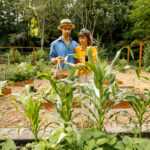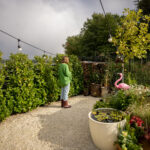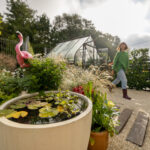A sensory garden is a special type of garden designed to stimulate and engage all five senses—sight, smell, taste, touch, and sound. It’s a space that invites exploration and provides a sensory experience that can be soothing, therapeutic, and enriching for people of all ages. Whether you are designing a garden for your own enjoyment or creating a peaceful sanctuary for others, a sensory garden can enhance well-being by connecting individuals with nature in a deeply immersive way.
In this article, we’ll walk you through the essential elements needed to create a sensory garden and provide tips for incorporating sensory-rich plants and features. Let’s dive into the world of sensory gardening and discover how to design a garden that offers a feast for the senses.
1. Engage the Sense of Sight
The visual appeal of your sensory garden is the first thing people will notice. To engage the sense of sight, incorporate plants and design elements that provide a range of colors, textures, and shapes. Here’s how you can stimulate the eyes:
- Colorful Flowers: Choose flowers that bloom in a variety of vibrant colors throughout the year. Bright and bold flowers such as sunflowers, marigolds, tulips, and daisies can create a lively visual display. For a more calming atmosphere, opt for softer colors like lavender, pale pink roses, or white lilies.
- Textural Variety: Plants with different textures provide visual interest and invite touch. For instance, combine soft, velvety plants like lamb’s ear with spiky foliage like yucca or ornamental grasses.
- Contrasting Shapes: Mix plants with different shapes and sizes—tall spires of foxglove, cascading vines of ivy, and rounded bushes of lavender can all work together to create a dynamic and visually exciting garden.
- Reflective Features: Add elements like mirrors, glass sculptures, or water features (such as a small pond or fountain) that reflect light and create intriguing visual effects.
2. Engage the Sense of Smell
The sense of smell is one of the most powerful ways to evoke memories and emotions. To stimulate this sense, focus on planting fragrant flowers and herbs that fill the air with pleasing aromas. Here are some ideas to create a fragrant garden:
- Sweet-Scented Flowers: Jasmine, roses, and honeysuckle are classic options for filling your garden with beautiful, sweet scents. Their fragrance can be especially potent in the early morning or evening when the air is still and cool.
- Herbs: Lavender, mint, rosemary, thyme, and basil are not only useful for cooking but also provide delightful scents when brushed or crushed. Growing herbs in your sensory garden allows you to enjoy their fragrance up close.
- Scented Leaves: Some plants, such as lemon balm, sage, or eucalyptus, have strongly aromatic leaves that release a wonderful fragrance when touched or brushed.
- Seasonal Scenting: Plan for a variety of scents at different times of the year. For example, plant lilacs or violets in the spring, peonies in the summer, and chrysanthemums in the fall to ensure your garden smells wonderful year-round.
3. Engage the Sense of Touch
The sense of touch is often the most overlooked in traditional gardens, but it can be one of the most rewarding elements in a sensory garden. Touching plants and garden features can bring you closer to nature. To engage the sense of touch:
- Soft, Velvety Plants: Plants like lamb’s ear, mullein, or silvery-leaved sage have soft, velvety textures that beg to be touched. They offer a soothing tactile experience when you brush your fingers across their leaves.
- Foliage Variety: Incorporate plants with different textures, such as the waxy, glossy leaves of succulents or the smooth, leathery leaves of bay laurel.
- Smooth Stones and Water Features: Include elements like smooth pebbles, smooth tree bark, or wooden benches that provide a tactile contrast to the plants. A gentle stream or bubbling fountain is also wonderful for touch and sound.
- Moss and Ground Covers: Plant ground covers like moss or low-growing herbs (such as thyme or chamomile) that create soft textures underfoot. These make a delightful, cooling touch when you walk barefoot through the garden.
4. Engage the Sense of Sound
A sensory garden isn’t just about visual beauty and delightful fragrances; it also has the power to engage the ears. Sounds in the garden can be peaceful and calming, creating a serene atmosphere. Here’s how to bring sound into your sensory garden:
- Water Features: The sound of flowing or trickling water is incredibly soothing. Install a small fountain, a birdbath with a gentle water flow, or even a small pond to introduce relaxing sounds into the space.
- Wind Chimes: Wind chimes made from bamboo, metal, or glass can add a soft, melodic sound when the wind blows. The gentle tinkling or ringing of chimes brings an element of tranquility to the garden.
- Rustling Leaves: Consider planting trees or shrubs with leaves that rustle in the wind, such as aspen or bamboo. The gentle swaying of branches and the soft rustling sound can create a calming atmosphere.
- Birdsong: Attract birds to your garden by planting native trees and flowers that provide shelter and food. Birds will naturally add their cheerful song to the mix, further enhancing the sensory experience.
5. Engage the Sense of Taste
The sense of taste is a delightful way to make your sensory garden even more rewarding. Plants that are edible and provide fresh flavors can be both beautiful and functional in your garden:
- Herbs for Flavor: Grow herbs like basil, mint, parsley, and cilantro for fresh, flavorful additions to your meals. These plants not only look good but also provide a burst of taste when used in cooking or teas.
- Edible Flowers: Many flowers are edible and can add a surprising and colorful touch to your meals. Nasturtiums, violets, and pansies are popular choices that offer a mildly peppery or sweet taste.
- Fruiting Plants: Fruit-bearing plants like strawberries, raspberries, and blueberries can be a delightful treat. Imagine walking through your garden and picking ripe berries directly from the bushes—this hands-on experience connects you with the plants and provides a satisfying sensory reward.
Conclusion: Creating a Sensory Garden for All Ages
Creating a sensory garden is about more than just planting beautiful flowers. It’s about designing a space that stimulates all five senses, providing an immersive experience that enriches the mind, body, and spirit. Whether you’re planting for yourself or designing a garden for others, be sure to include a mix of colors, textures, smells, sounds, and tastes to create a truly sensory-rich environment.
By focusing on easy-to-care-for plants and thoughtful garden features, you can create a sanctuary that encourages mindfulness, relaxation, and a deeper connection with nature. A sensory garden is not just a place to escape—it’s a place to experience the world through the beauty of the senses.









